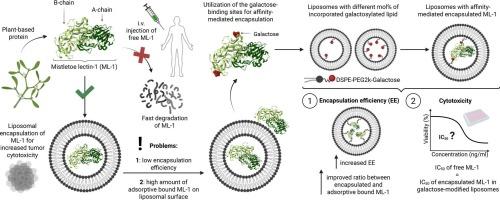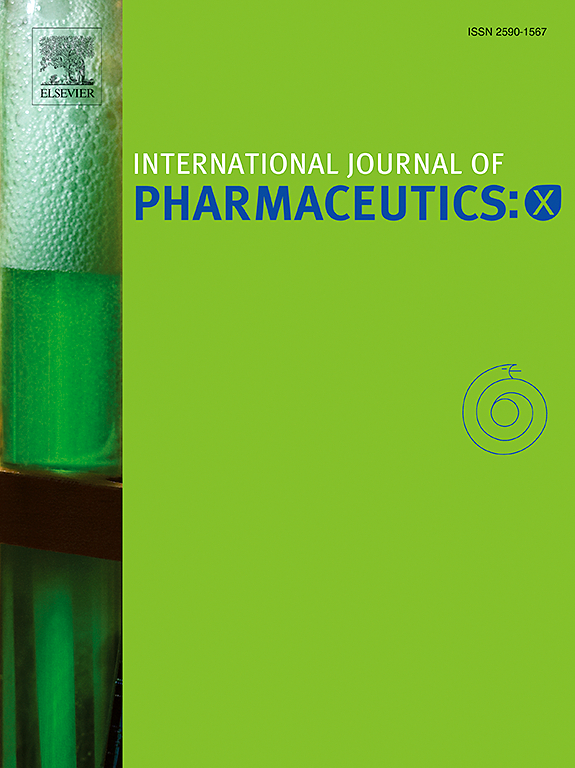Galactosylated liposomes for targeted encapsulation and enhanced cytotoxicity of Mistletoe Lectin, an antitumoral type 2 ribosome-inactivating protein
IF 6.4
2区 医学
Q1 PHARMACOLOGY & PHARMACY
引用次数: 0
Abstract
The development of efficient liposomal encapsulations of proteins for pharmaceutical applications is limited by several factors: their high molecular weight, interactions with surrounding substances, or the generally lower stability compared to small molecules. In this work, various liposomal formulations were prepared using the thin-film hydration method followed by extrusion, to investigate their suitability for the encapsulation of the plant-derived antitumoral mistletoe lectin-1 (ML-1). This can be significantly optimized by exploiting its preferential binding to galactose-containing structures, such as modified lipids integrated into the liposomal bilayer. Incorporation of the galactosylated lipid DSPE-PEG2k-Gal into the membrane significantly enhanced the overall recovery rate and encapsulation efficiency of ML-1, attributed to its affinity for the functionalized component. Compared to non-functionalized liposomes, a 2-fold to 4-fold increase in percentage encapsulation efficiency was observed. The galactosylated lipid optimized the ratio of encapsulated to surface-adsorbed ML-1 and facilitated its preferential localization within the core of the liposomes. A strong correlation was identified between the number of entrapped ML-1 molecules per liposome and the degree of galactosylation. The formulations demonstrated high in vitro cytotoxicity, as exemplified with murine colon-26 carcinoma cells, with the galactose-functionalized liposomes achieving an IC50 value comparable to free ML-1. This strategy presents significant potential for developing more efficient and targeted liposomal formulations of pharmaceutical proteins with specific affinities to tailored lipid components, advancing drug delivery technologies, and improving therapeutic options for cancer treatment.

槲寄生凝集素是一种抗肿瘤2型核糖体失活蛋白,半乳糖化脂质体用于靶向包封和增强细胞毒性
用于药物应用的高效蛋白质脂质体包封的发展受到几个因素的限制:它们的高分子量,与周围物质的相互作用,或者与小分子相比通常较低的稳定性。本研究采用薄膜水化法和挤压法制备了不同的脂质体制剂,考察其对植物源性抗肿瘤槲寄生凝集素-1 (ML-1)包封的适用性。这可以通过利用其与含半乳糖结构的优先结合来显着优化,例如整合到脂质体双分子层中的修饰脂质。半乳糖化脂质DSPE-PEG2k-Gal加入膜中,由于其对功能化组分的亲和力,显著提高了ML-1的总体回收率和包封效率。与非功能化脂质体相比,观察到百分比包封效率增加2至4倍。半乳糖化脂质优化了被包裹的ML-1与表面吸附的ML-1的比例,并促进了其在脂质体核心内的优先定位。在每个脂质体中捕获的ML-1分子数量与半乳糖基化程度之间存在很强的相关性。该制剂显示出高的体外细胞毒性,如小鼠结肠癌-26细胞,半乳糖功能化脂质体达到与游离ML-1相当的IC50值。这一策略为开发更有效和靶向的药物蛋白脂质体配方提供了巨大的潜力,这些药物蛋白与定制的脂质成分具有特定的亲和力,推进了药物输送技术,并改善了癌症治疗的治疗选择。
本文章由计算机程序翻译,如有差异,请以英文原文为准。
求助全文
约1分钟内获得全文
求助全文
来源期刊

International Journal of Pharmaceutics: X
Pharmacology, Toxicology and Pharmaceutics-Pharmaceutical Science
CiteScore
6.60
自引率
0.00%
发文量
32
审稿时长
24 days
期刊介绍:
International Journal of Pharmaceutics: X offers authors with high-quality research who want to publish in a gold open access journal the opportunity to make their work immediately, permanently, and freely accessible.
International Journal of Pharmaceutics: X authors will pay an article publishing charge (APC), have a choice of license options, and retain copyright. Please check the APC here. The journal is indexed in SCOPUS, PUBMED, PMC and DOAJ.
The International Journal of Pharmaceutics is the second most cited journal in the "Pharmacy & Pharmacology" category out of 358 journals, being the true home for pharmaceutical scientists concerned with the physical, chemical and biological properties of devices and delivery systems for drugs, vaccines and biologicals, including their design, manufacture and evaluation. This includes evaluation of the properties of drugs, excipients such as surfactants and polymers and novel materials. The journal has special sections on pharmaceutical nanotechnology and personalized medicines, and publishes research papers, reviews, commentaries and letters to the editor as well as special issues.
 求助内容:
求助内容: 应助结果提醒方式:
应助结果提醒方式:


